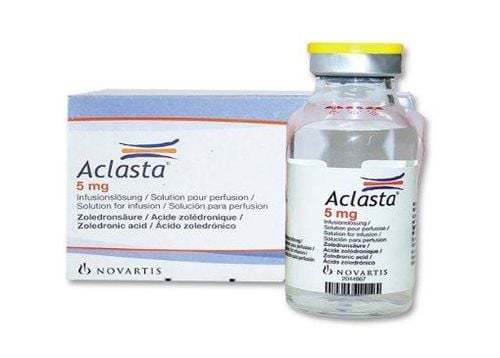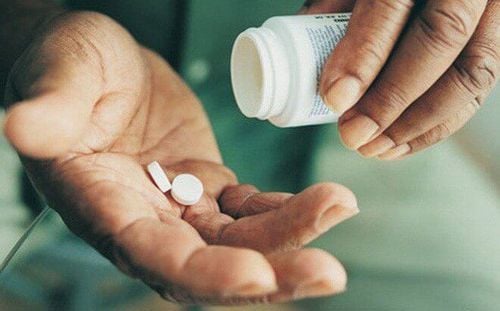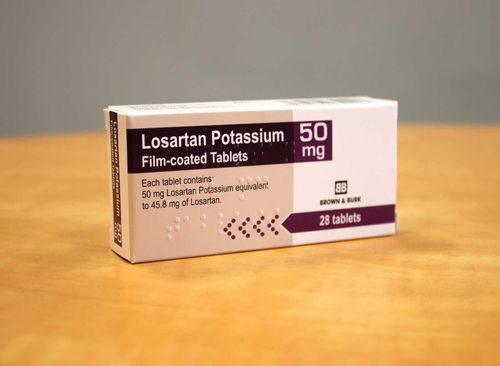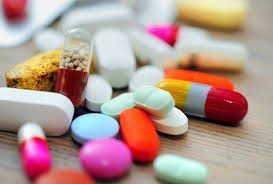This is an automatically translated article.
Each patient after an accident, stroke or cerebral vascular injury has different limitations in movement and impairment of functions. This article provides patients and family members with necessary information as well as ways to practice at home to restore motor function and walking.
Although the patient's family knows that recovery is limited, if the patient steps back and does not exercise regularly, or does not exercise properly, the impairment will worsen. aggravate them and possibly paralyze them . It is our hope that this document will provide the most basic yet effective information on methods to help patients exercise, to maximize possible recovery and help patients gain confidence. back to everyday life.
1. Some information about rehabilitation?
Rehabilitation is a multi-step exercise process that helps patients restore the functioning of organs and organs after damage or functional decline due to many factors such as accidents, complications of spinal diseases, after major surgery, after a stroke,... Rehabilitation training can help patients regain their mobility, mobility and multi-tasking ability. part of daily activities.
In addition, this method also works to reduce the risk of disease recurrence after treatment, prevent and prevent disability due to pathological factors. For people with disabilities, rehabilitation helps them better deal with problems, adapt to their living environment and reintegrate into society.
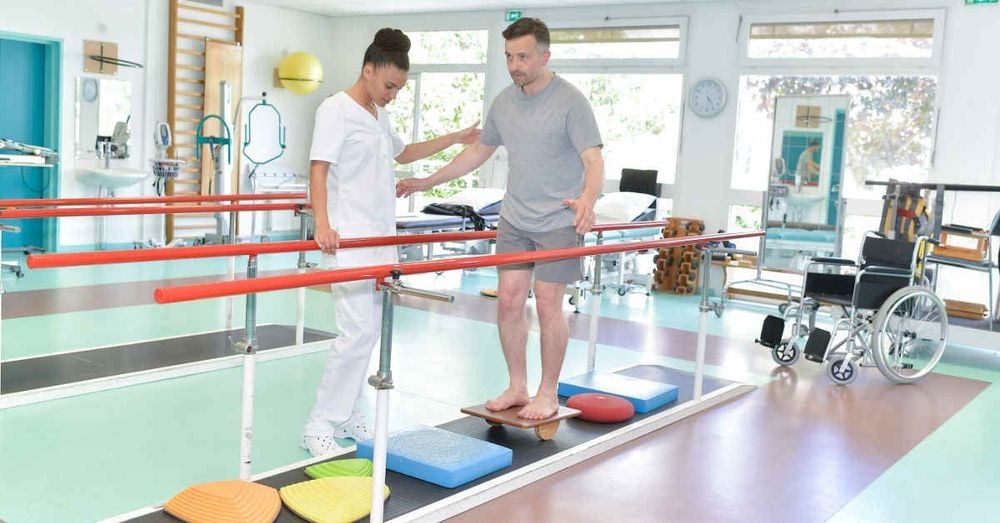
Vận động giúp phục hồi các chức năng của bộ phận trên cơ thế
Rehabilitation measures :
Psychological rehabilitation Physiotherapy Motor rehabilitation Speech and language therapy Therapeutic activities Rehabilitation purposes:
Rehabilitation of the functional organs Parts and organs are damaged, disordered, impaired or deprived of normal movement Restoration of senses due to disease. Reduce the risk of disability and disability. It also prevents some other complications caused by medical conditions. Support to improve the treatment effectiveness of other combined treatment methods. Help patients restore mobility, move more easily and flexibly, no longer depend on the help of others. Helping patients be able to live independently, adapt to the current living environment, have the ability to work better and improve their quality of life. Reduces the risk of disease recurrence after treatment. Improve overall health and promote joint health. Help patients be optimistic, happy and easily integrate into society. It also helps control stress at work. Positively change living, studying and working conditions for people with disabilities. Helping patients make the most of and develop to their fullest potential mentally, physically, socially and economically. Thereby helping disabled people become useful people for society.
2. Diseases requiring rehabilitation of movement and walking
Degeneration of joints, osteoarthritis pain due to injury, due to old age: Treatment with exercises to reduce joint pain, limit degenerative joint disease, improve joint flexibility and improve strength bone health. Osteoarthritis, joint pain, shoulder and arm syndrome, muscle strain, dislocation: For cases of arthritis, joint pain, arm shoulder syndrome, muscle strain, dislocation... due to trauma impact, strenuous sports or hard labor, patients can be treated in combination with rehabilitation exercises with a number of other methods. Typically, laser irradiation, shock wave, electrical pulse, IR infrared irradiation.
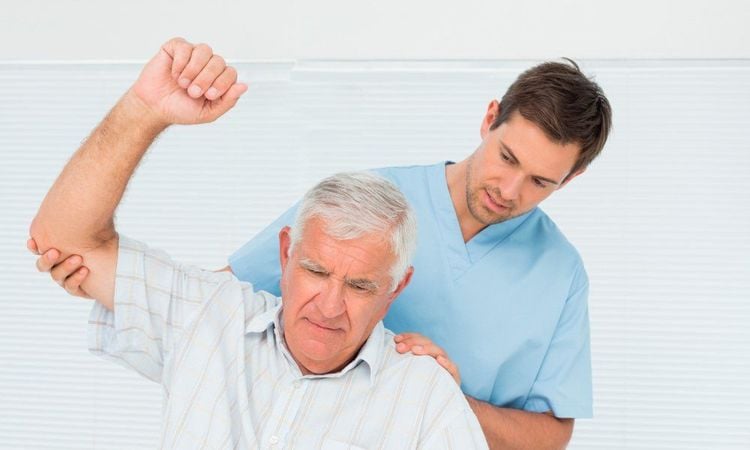
Phục hồi chức năng cần thiết ở những người mắc các bệnh về xương khớp
Dislocation, disc herniation, back - hip pain, dislocation, scoliosis, ankylosing spondylitis: For these diseases, the patient will be treated and rehabilitated with a tractor DTS spinal decompression. Surgery for traumatic brain injury, joint replacement, knee ligament replacement, spinal neuropathy: After the surgery, the patient will be applied a number of exercises to restore motor function, mobility and flexibility of the limbs. Stroke, traumatic brain injury, orthopedic surgery, coronary heart disease, overweight and obesity, spinal cord injury, multiple sclerosis, cerebral palsy, geriatric rehabilitation...
2. Rehabilitation of movement, walking
2.1. Walking rehabilitation exercise
Walking can be seen as a static posture that reflects during movement, because the human body tends to fall to the ground due to gravity, and to stand upright requires contraction of the upper body muscles able to resist gravity.
Normally, the weight of both feet is distributed on the inside and outside of the heel, under the big toe, under the little toe, and on the outside edge of the sole because of the arch. Humans, during continuous walking every 15 minutes, the foot with the main negative center of gravity will self-correct, if the foot when there are structural problems, such as flat feet, high arch, challenge, etc., the ability to self-correct, the legs in some areas bear the load for a long time, continuously, leading to muscle pain in the feet, often long calves, calloused
Leg feeling exercises:
Standing feet shoulder width apart and feet forward. Move your body forward and backward, feel the distribution of your weight in different places on the soles of your feet, and focus on the center of gravity of the soles. Then move your body from side to side, while feeling the distribution of your body weight at different locations on the soles of your feet.
After 4 minutes of exercise, with dumbbells placed between the soles of your feet and chest breathing as the main method, open your entire chest to the outside, stretch the main muscles of the psoas and feel the whole body pull stretch.
1-Step Exercise: Stand with your feet shoulder-width apart, lift your right leg up, evenly distribute your weight to the 5 load-bearing zones on the bottom of your left foot, balance your calf muscles and hold for 5-10 seconds. Lift left leg and repeat.
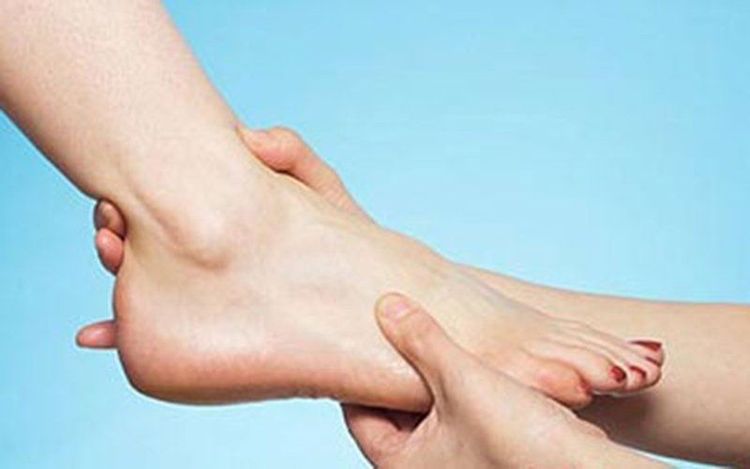
Bài tập cảm giác chân giúp tăng khả năng phục hồi
One step plus chest rotation: As you take a step, lift your right foot and rotate the rib cage a few degrees to the right and back so your weight is more evenly distributed on the bottom of your foot.
Learn to walk:
Stand with feet shoulder width apart, push off the ground with the front end of your right foot, slightly rotate your rib cage back to the right, swing your left arm forward, moving your muscle weight forward, placing the right heel on the ground. Total gravity is on the center of gravity of the foot, raise the left leg in the same direction, rotate the chest to the left and back, swing the right arm forward. Complete a gait cycle in the same manner.
Once your weight is evenly distributed on your feet, start walking. Requirements: When walking, you must shoulder the weight of both feet, shoulder width apart, toes pointing straight ahead.
2.2. Upper limb rehabilitation
Depending on the clinical stage and stability of fracture healing, it is generally divided into four stages.
First stage: Local pain and swelling of the limbs appear 1-2 weeks after the injury.
The purpose of rehabilitation exercises is to promote swelling, prevent muscle atrophy, and prevent joint adhesions.
The main methods are as follows: Fist, arm lift, shoulder lift. Making a fist is the basic movement of the upper extremities. Try to keep your fingers perfectly straight and flexible. Then do arm lifts and shoulder lifts. If the fracture is near the metaphyseal end, a certain range of joint action may also be performed to stabilize the fracture.
Stage 2 injury 3-4 weeks after injury: If the patient's muscle strength is restored and there is no pain at the fracture, the patient can perform some automatic extensor and flexion activities in the upper extremities. , start with one joint, then practice multiple joints together.
Injury stage 3 5-7 weeks after injury: In addition to limiting joint activity in one direction which is not conducive to fracture healing, joint activity in other directions can be increased to the extent possible. of patients, both in terms of number and range of activities.
8 - 10 weeks after a stage 4 injury: The person may be allowed to do some light work.
Rehabilitation of limbs on passive activities
When the patient has muscle weakness, unable to move on his own, he should perform complementary activities with the help of medical staff. For example, patients with multiple fractures, multiple limb fractures, intra-articular fractures, or other systemic complications and are unable to perform their own activities may be assisted by passive activities. .
If local massage is suitable for fractures and severe swelling of the extremities, its purpose is to dissolve blood stasis, promote circulation, and prevent adhesions. Manipulation must be gentle, without increasing pain, aggravating local trauma or displacing the fracture.
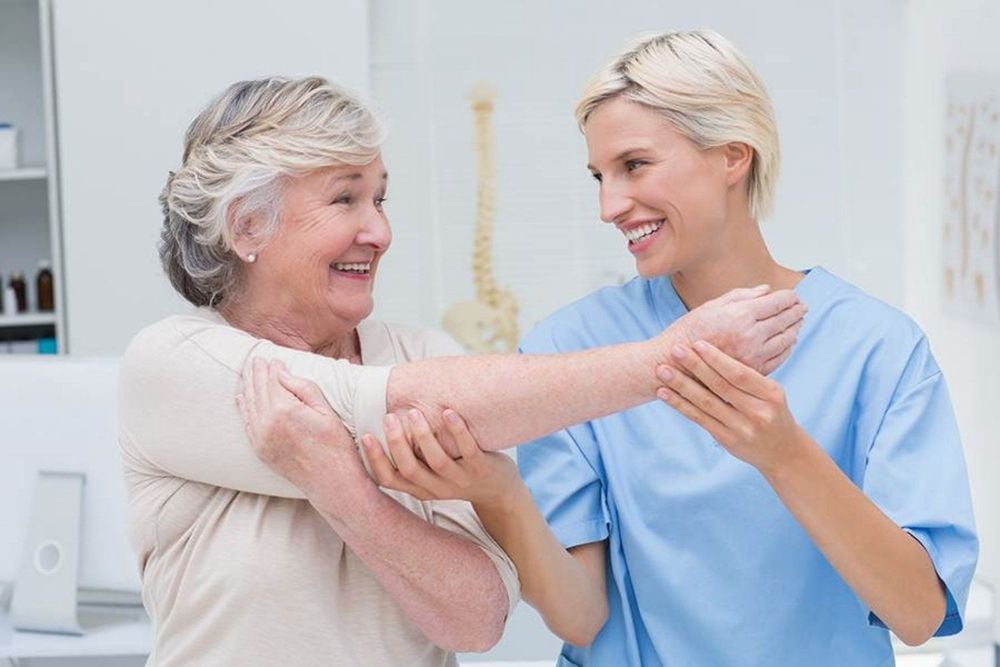
Phục hồi chức năng ở các chi trên bằng cách xoa bóp
Rehabilitation after a fracture is not a simple rest that can be healed but requires a combination of movement and seclusion, that is, a combination of rest and exercise. It mainly includes three aspects:
First, the growth of scar tissue: After the continuum of the backbone of the human body is destroyed, the osteoblasts and osteoclasts on the periosteum will activated, and the continued growth of these two types of cells leads to fractures. The end of the repair and connection process, which is the formation of the scar tissue.
Factors that influence callus growth include:
Poor connection at the fracture tip. Malnutrition . Lack of movement. Second, joint range of motion: Full restoration of the injured joint's range of motion is the ultimate rehabilitation goal of fracture treatment, which is important.
Third, rehabilitation: Actively promote the rehabilitation of damaged limbs. Massage enhances circulation, reduces muscle contractions, and limits muscle weakness.
2.3. Finger Restoration
Encounter hemiplegia and want to return to normal, it is best to go to a doctor to practice finger rehabilitation to practice well every day, but for specific exercise, everyone I don't quite understand, so how to practice finger rehabilitation?
-The effect of the lateral limb mimic synapse is used as a similar action to cause the action of difficulty, when the patient wants to flex the lateral fingers, we can see the lateral fingers bent, sometimes even reaching into subconscious action to cause. The fingers are lateral flexed, but if control is observed, the lateral hand is not subject to the flexion, may instead inhibit the fingers straight down as described above Alternating rotation and extension, or in the early stages of practicing finger grip and release, the effect is caused especially in the flexion movement, and attention should be paid to the mimic (side) hand, to determine if the fist is not being held too tight so that the arm muscles are overworked.
General grip training wrist, wrist fixation and finger flexor muscle are closely linked, and this condition often occurs after cerebral blood vessels are blocked, so it is necessary to rebuild to effective capture.
Expanding the group and stimulating the telescopic reflex: The strength of the involuntary hand should be enhanced, and the strength of the involuntary open hand is equally important. The flexor muscle of the finger is contracted, causing the thumb to fold inward to the other four fingers. When spasm is present and the patient is unable to straighten his or her fingers, alternate automatic grasping with passive palmar opening to relieve tension. Therapists can gently and quickly brush the back of the patient's hand and wrist when the forearm is rotated, effectively relieving flexor tension. When the patient has only spasticity in the wrists and fingers, it can be relieved by prolonged cold water stimulation.
Hand rehabilitation can be achieved by training fingers for grip and fine motor activities
2.4. Lower extremity rehabilitation
Lower extremity training and rehabilitation system has the function of helping joints recover movement quickly after operation, joints can move freely after recovery. This system for the knee and ankle areas has a stabilizing auxiliary device, which can make the patient's hand move the handle, actively control the movement of the lower limb, and then make the leg move. , respectively, help the patient establish the correct sense of input during movement, and guide the correct movements. Motion pattern, effectively improve muscle atrophy, stiffness, increase movement control.
Therapeutic effects:
Improve joint motion angle Enhance muscle strength and endurance; Limit abnormal muscle tension and reduce spasms; Improved irregular motion mode; Improve balance function and motor coordination function; Improve cardiopulmonary function and digestive function
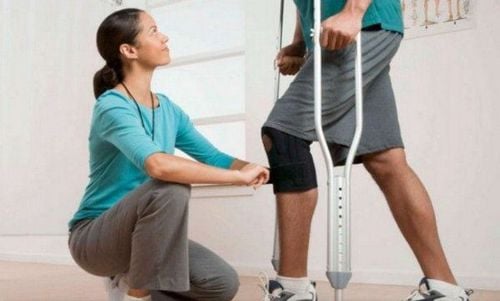
Phục hồi chức năng ở chi dưới mang lại nhiều hiệu quả
Lower extremity rehabilitation training should be performed according to the patient's condition and following the principle of incremental rehabilitation exercise to achieve the goal of early recovery. Passive exercise: Exercise performed entirely with the help of an external force, including a doctor, family member, rehabilitation equipment, healthy limbs, etc., to maintain range of motion normal or existing movement of the joint and prevent spasticity and deformity. Pay attention to passive movement that does not cause obvious pain, when touching, there is a feeling of joint stiffness, avoiding rough forced movement.
The comprehensive rehabilitation exercise of limbs has a certain motivating effect on improving brain function. Meanwhile, rehabilitation exercise can accelerate the establishment of collateral circulation in brain tissue, promote reorganization and compensation of brain cells surrounding the injury, and is beneficial to "plasticity." toughness” of brain tissue.
2.5. Full body movement rehabilitation
Whole-body rehabilitation is physical activity that is beneficial for recovering or improving function after injury. With the exception of severe injuries that require rest and treatment, common injuries do not require complete cessation of movement. Scientific and appropriate physical exercise has a positive effect on quickly healing injuries and promoting rehabilitation
To maintain good health, can prevent muscle atrophy and contraction stiffness through rehabilitation exercise, maintaining healthy limb mobility and good cardiopulmonary function so that normal exercise can be resumed immediately as the wound heals.
To prevent suspension syndrome. Individuals in the process of long-term physical exercise to establish many conditioned links, once abruptly stopping exercise can be destroyed, and subsequently produce serious dysfunctions, such as: neurasthenia, gastric dilatation, digestive dysfunction, etc.
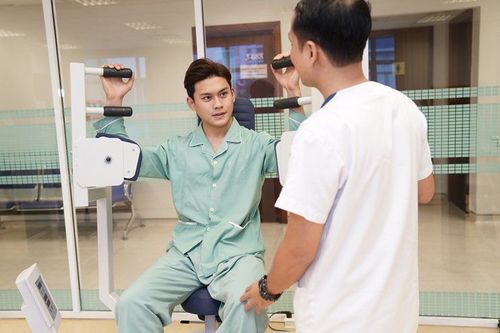
Phục hồi chức năng toàn bộ cơ thể là các hoạt động thể chất mang lại nhiều hiệu quả tích cực
Proper rehabilitation exercises after injury can enhance joint stability, improve metabolism and nutrition of wound tissues, accelerate wound healing, and promote healing unity of function, form and structure.
Rehabilitation exercise after injury can balance the body's energy metabolism, prevent weight gain and shorten the recovery time after injury.
Principles of whole-body rehabilitation exercise
Accurate diagnosis: A scientific and reasonable rehabilitation plan must be based on an accurate and comprehensive diagnosis. Misdiagnosis or incompleteness will delay and impede the healing process of the injury. If lumbar spine fracture is often combined with disc protrusion, especially massage manipulation, it will not be easy to move to the strong side. If it is combined with spondylolisthesis, back strength exercises should not be overextended.
Individual treatment : Depending on age, disease, functional status, training method, preparation posture and amount of movement to develop and improve muscle function (strength, speed, endurance) ) and range of motion.
Post-traumatic rehabilitation training on the basis of not aggravating the injury and not affecting wound healing. Systematic and local activities should be avoided as much as possible. Also, the sooner you start working out the injured muscles, the better.
Rehabilitation training plan follows the principles of comprehensive training, gradual progress and appropriate large amounts of movement. During the healing of the injury, the amplitude, frequency, duration and volume of rehabilitation action should be gradually increased. Otherwise, it will aggravate the injury or affect the healing process, and may even make the wound untreated for a long time and become an old wound. Rehabilitation training should pay attention to a combination of specialized local exercises and comprehensive physical activities. In the early stages of injury, due to swelling, local congestion, pain and dysfunction capacity, comprehensive physical activities should be prioritized, performing locally appropriate activities in a facility that does not aggravate local swelling and pain. As the wound gradually improves or tends to heal over time, the amount and duration of local activity can be gradually increased.
Please dial HOTLINE for more information or register for an appointment HERE. Download MyVinmec app to make appointments faster and to manage your bookings easily.




